The Old Okinawan Karate Toe Kick:
Part 1- Introduction & Execution
By Christopher Caile
Editor's Note: This article is the first in a series
on toe kicks as practiced in old Okinawan karate. Part 1 of this series
introduces the subject and provides the basics of how this kick is performed.
Part
2 will discuss some of the great masters who used this technique,
their targets and some of the strategy of applications. Part 3 will discuss
the conditioning and development of the toes that is necessary to use
this kick effectively without injury to oneself.
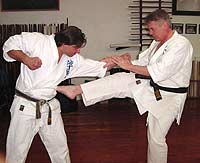 |
The tip of the toe kick (tsuma saki)(1) was practiced as part of
old Okinawan karate. Here it is used to target the floating ribs
as the arm is captured and pulled back. |
Not long ago after karate class I was practicing a special old Okinawan
form of front kick. Another student was watching and after I finished
he asked, “What kind of kick was that? It looks like you were kicking
with your toes.”
“Yes, I replied. “It is the old form of front kick, not
usually seen. In our style (Seido Juku Karate) it is only taught to a
few senior students. It’s very powerful, but to make it work the
toes need a lot of conditioning.”
The student’s response was not unusual. “Ouch, forget that.
I try to avoid hitting my toes, not kicking with them.” This is
an understandable response. Teaching toe kicks to most students would
only result in broken toes and loss of these students.
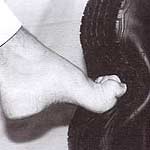 |
Uechi ryu karate has its own unique method of toe kick using the
tip of the big toe (called Sokusen). In this kick the toes are pulled
back (in a bent position) and tightened into position. In this style
it is the only kick used in the kata brought back from China. (Photo
courtesy of Alan Dollar). |
In the early 20th century in Okinawan karate the toe kick was common.
Today, however, even in Okinawa many styles, such as Goju Ryu no longer
actively teach this kick, although there are exceptions. (4) The kick
is also recognized in Shotokan and some other Japanese styles including
my own Seido Juku, but is very rarely taught. Only within the Uechi Ryu,
some Shorin-ryu styles such as Kishiba Juku, Matsybashi and Matsumura
Seito, does the toe kick play an important role in their teaching. (5)
Toe kicks using the tip of the toes as a striking surface can be very
powerful, precise and penetrating. If they target weak points in an opponent’s
body structure (pressure points), they can also disable. They are also
perfectly suited to the modern world where people wear leather or hard
tipped shoes – the toe of which can prove to be an effective pinpoint
weapon.
Sensei Jeff Brooks, a Matsubayashi Shorin Ryu stylist (where the toe
kick is taught as a primary weapon) (6) notes that it “is very
valuable for all martial artists to know. Most confrontations happen
outside the dojo and mostly you will be wearing shoes. With a toe tip
kick you get the maximum penetration of the full wedge of the foot. And
what’s more, with or without shoes, the entire force of the kick
is delivered by and focused into a small area, for multiples of force
per square area greater than the equivalent power behind a ball kick.”
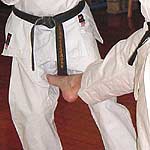 |
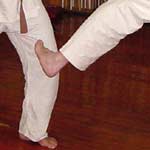 |
Traditionally, the toe kick was used in a number
of ways, such as a snap kick, or low round kick to the opponent’s
front or rear leg. Usually the front leg was used for this kick,
which is more snapped than driven with the hips (a front leg kick
not being able to utilize the hips as well as one using the rear
leg). |
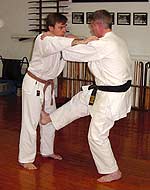 |
While toe kicks can
directly target the groin, an even more devilish old technique
was to angle
the toes upward
to kick under and behind the testicles (if a man). (7) After contact
the knee continued to be lifted and pulled back so the toes pull
forward and up –ouch. |
| |
|
If the opponent’s arm is captured and an
arm bar applied, a vertical ascending kick into the face or neck
can
be devastating and potentially fatal. (8) |
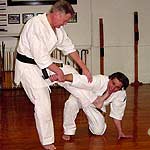
|
Usually the front leg is used for toe-tip kicks. It is a fast offensive
or defensive weapon (able to block a kick). The knee is lifted and the
kick is snapped into the target, but without driving with the hips as
is often used when the back leg is used for snap kicks. Execution is
very fast. Since most targets are usually low, the distance traveled
is short.
Many old Okinawan kata applications, te (old Okinawan indigenous fighting
techniques) and torite (capturing and restraining techniques) (9) techniques
combine blocks, grabs, and strikes along with off balancing or tripping.
These will often be taught as one, two three combinations, but advanced
practitioners will perform them simultaneously.
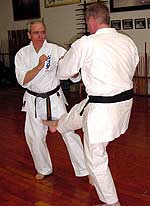 |
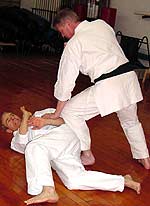 |
Here, in a simulated
self-defense situation, I use my left hand to catch and pull my
opponent’s left lead hand forward (forcing his weight forward
on his front foot) while I toe kick to the mid-point of the inside
of his thigh (femoral nerve). Not only is this very painful, but
this kick can effect motor nerve dysfunction, causing his leg to
collapse. (10) Stepping in with my left leg I can use my knee to
pin my opponent on his side (keeping him from rolling toward me),
ready to finish with a right punch.
|
The rear leg can also be used for a toe kick in self-defense and in
freefighting. Like a reverse punch, the back leg toe kick can produce
more power by adding the hip and the body into the attack, but it is
slower to target since it must travel a longer distance.
During the execution of both front and rear leg toe kicks the kicking
leg can be quickly withdrawn. Greater effect is generated, however, if
the kick is held on the target for a fraction of a second. Phillip Koeppel
Sensei, who teacher Matsumura Seito Shorin ryu karate (head of the United
States Karate-Do Kai) (11) stresses the importance of keeping the toe
on target for a short period to maximize the neurological impact of the
kick. Research has also shown that neurological target points have greater
response if a strike continues to maintain contact for 3/10th of a second.
(12)
Some teachers and styles of karate, however, teach to withdraw the kicking
foot quickly. This prevents the leg from getting caught and allows execution
of repeated kicks. In Uechi-ryu, for example, the front hand like the
front foot is considered the first line of defense. Being closest to
the opponent, both the front hand and front foot can be quickly executed
toward an incoming attacker.
In kicking with the toes, remember to keep the foot flat when the knee
is cocked if the kick is short and horizontal, such as to targets on
the inside of the lower leg. The angle of the kick can also rise, such
as when kicking into targets like the lower abdomen. But be careful,
if the toes are angled to far upward the kick will slip off its target.
When kicking vertically upward with the toes, the ankle is bent.
If you have been born and bred on the standard ball of the foot front
or roundhouse kick, however, you will at first find the toe kick hard
to execute. Your toes will seem to rise when you lift your foot. And
if you are trained to keep your ankle straight (toes up) and you lift
your foot for a front kick, trying to keep the ankle bent (the foot flat)
and toes down too will prove to be a daunting task. It takes practice.
Watch for the next article in this series which will discuss a variety
of subjects including: famous masters who used toe kicks, targets, combinations
techniques, and strategy.
Disclaimer: This article is for educational purposes only. The intent
of this article is to provide information on the historical roots of
the technique and practices related to the development and methods of
early karate and related arts. It is not the intent for the content of
this article, or techniques demonstrated or discussed herein to be practiced
or adopted within the curriculum of present day martial arts practice.
The techniques described and illustrated may seriously harm an opponent
or training partner and readers are not encouraged to use or practice
them. If the reader wants to perform any martial art technique he or
she is advised to do so only with proper supervision and training of
a qualified instructor or teacher certified within the art to be practiced.
Footnotes:
(1) The toe kick is also alternately called tsumakasaki geri, ashi no
yuba (toes), or ashi nukite (foot spear). In Uechi Ryu karate it is known
as sokusen.
(2) I started practicing toe
kicks in earnest when I was allowed into a small Chinese family martial
arts system in Toronto. Of course in most
Chinese systems shoes were worn, although they were flexible. In China
this tradition of using toe kicks is widespread. One Chinese system specializes
in them, Tam Tuie (Tam Toy, Tom Toy, et al). This system consists of
one form (versions from 10 to 12 to more rows of techniques). A row is
a series of techniques done in an east-west axis, and then the row reverses
in the opposite direction for the next series (often found in Northern
systems of Shaolin, Tai Chi, N. Mantis, N. Eagle Claw, etc). One form
is a complete system in its own right. The kicks are delivered with great
force and at toe, ankle and lower shin heights as well as into the mid
leg range. The kicks are practiced with a lock out focus, and there are
layers of delivery. One advanced variation has the toes dragged across
the floor to slingshot off the floor at the end for a very different
angle of delivery, where the first variations are thrust kicks out parallel
to the floor. The famous Jing Mo (Ching mo, et al) association used it
as one of the dozen basic forms all members first studied (all of which
are very complex in their own rights). Jing Mo members would then study
their instructor’s primary arts, such as Northern Eagle Claw, after
those forms for basics. The art of Faan Tai Ying Jow Pai, utilizes the
entire range of Chinese kicking technique (including aerial and ground
technique) and in the most advanced forms, Tam Tuie kicking is most definitely
a part of the study. (I want to thank Victor Smith for supplying some
of the above information.)
(3) This is the preferred toe kick position in many styles of Okinawan
karate. Many old masters, however, used the natural toe position, including
Kaicho Tadashi Nakamura of my own Seido Juku Karate. I have also seen
photos of feet where the toes are wrapped down and balled (like a karate
fist) so the striking surface is the first and second big knuckle of
the foot. This is very unnatural for most people, however. It takes training
from birth and is virtually unseen today.
(4) While training in Miyazato
Ei’ichi’s Jundokan (Goju-Ryu)
in Naha, Okinawa in 1994, for example, I never saw the toe kick used
(Miyazato is one of several Okinawan teachers who were senior students
of Chojun Miyagi, founder of Goju-Ryu karate. Miyazato is considered
one of the inheritors of Miyagi’s system) . According to Glenn
Cunningham (Jundokan for NYC), he asked Masaji Taira (a leading teacher
in the Naha Jundokan headquarters, who is known for his innovative kata
applications) about toe kicks and was told that toe kicks were still
used occasionally, but were taught primarily to kick up under the groin
when you had captured an opponent’s kicking leg.
(5) It is perhaps understandable
that many aspects of old Okinawan karate were changed when teaching
changed from small groups of dedicated students,
to a larger class structure in Okinawan schools, to GI’s (on Okinawa)
or in Japan, to the general public and university students. Emphasis
changed. The goal of karate was no longer life-and-death self-defense
and personal protection. In the Okinawan school system in the early 1900’s
karate was used as a means of physical development. When it was transplanted
to Japan karate eventually joined judo and kendo as a means of personal
discipline and spiritual development. In its new role painful body conditioning,
and especially toe conditioning, were seen as irrelevant. Why take years
conditioning the toes when by simply bending them up and kicking with
the ball of the foot a student could quickly learn to do an effective
front kick?
(6) Many readers of FightingArts.com
will recognize Jeff’s name.
He is a frequent contributor who writes articles about Zen. He also writes
a column under the name of the Zen Mirror. Jeff’s new book “Tje
Rhinoceros’s Tale” can be found in FightingArts.com’s
e-store under “Books”, in the category “Zen And The
Martial Arts.”
(7) This is a very vulnerable
point, which some texts consider a death point (known as “perineum” in
Traditional Chinese Medicine).
(8) This type of technique
is also seen in many styles of jujutsu. In diato-ryu aikijujutsu, for
example, this kick is also the finish to the
basic technique of Ippon Dori. The technique starts where an opponent’s
downward sword cut is stopped and redirected down and to the side by
dropping the body forward and down toward the technique while intercepting
the opponent’s arm (under the elbow) with your left open hand (catching
the impact with the little finger side of the lower palm). The attack
is then further redirected down and to the side. Arm bar is applied with
a kick to the neck or face, and then body weight is applied to the arm
bar to break the elbow. Of course practice is much gentler.
(9) This point is sometimes
referred to as the “The Blood Point” because
a sharp blow can also effect a major vein running through this area (great
saphenous vein) causing the inside of the thigh to turn black and blue.
(10) Te and torite techniques
were often taught by some old masters, such as Hohan Soken along with
karate and kata. They were often practiced
side by side and seen as complementary. Te means hand and it refers to
a category of old Okinawan open hand and weapon techniques that existed
prior to the development of modern karate. Many historians believe that “te
(also known a “ti”)” techniques were combined with
Chinese fighting methods during the development of karate (which originally
too had different names). Many torite techniques, however, are also embedded
within kata, but difficult to recognize. Torite techniques are in some
styles referred to a “karamiti” or “kakushu”.
They are complementary to what some call “muchini” (drapping
and sticky hand movements) used as part of the above.
(11) Koeppel is a 10 dan,
and head of a large international karate organization that teaches
traditional Okianwan karate based on the teachings of the
legendary karate master Hohan Soken. Koeppel has 40 + years of karate
experience under the tutelage of some of Okinawan great teachers including
Fusei Kise, Yuichi Kuda and Kousai Nishihira– all inheritors of
Hohan Soken’s White Crane influenced old-style karate system passed
down from Bushi Matsumura, the great Okinawan master and fountainhead
of Okinawan karate practice. Koeppel was this author’s first teacher
(1959). On my travels to Peoria, Illinois where he is based (a former
family business) I was able to continue my relationship with Koeppel.
He is very knowledgeable.
(12) Research done by the
PPCT Management Systems, Inc. in the early 1980’s, a company specializing in teaching defensive tactics to
law enforcement personnel, included the use of specific pressure points
to assist in gaining compliance when necessary. Their research found
that different types of strikes seem to elicit different muscular reactions.
The most reliable motor (muscular) dysfunction (which inhibits secretion
of the neural transmitter acetylcholine which acts to fire resistive
muscle action) for targets identified to be struck was when the target
received maximum kinetic energy transfer. This was achieved with what
they called, “the fluid shock wave” strike which “sticks” to
the target for one third of a second. This allows weight and forward
momentum to dissipate into the target (thick muscle mass), which maximizes
kinetic energy transfer. The results included motor dysfunction and mental
stunning.
About The Author:
Christopher Caile is the Founder and Editor-In-Chief of
FightingArts.com. He has been a student of the martial arts for over
43 years. He first started in judo. Then he added karate as a student
of Phil Koeppel in 1959. Caile introduced karate to Finland in 1960 and
then hitch-hiked eastward. In Japan (1961) he studied under Mas Oyama
and later in the US became a Kyokushinkai Branch Chief. In 1976 he followed
Kaicho Tadashi Nakamura when he formed Seido karate and is now a 6th
degree black belt in that organization's honbu dojo. Other experience
includes judo, aikido, diato-ryu, kenjutsu, kobudo, Shinto Muso-ryu jodo,
boxing and several Chinese fighting arts including Praying mantis, Pak
Mei (White Eyebrow) and shuai chiao. He is also a student of Zen. A long-term
student of one branch of Traditional Chinese Medicine, Qigong, he is
a personal disciple of the qi gong master and teacher of acupuncture
Dr. Zaiwen Shen (M.D., Ph.D.) and is Vice-President of the DS International
Chi Medicine Association. He holds an M.A. in International Relations
from American University in Washington D.C. and has traveled extensively
through South and Southeast Asia. He frequently returns to Japan and
Okinawa to continue his studies in the martial arts, their history and
tradition. In his professional life he has been a businessman, newspaper
journalist, inventor and entrepreneur.
|